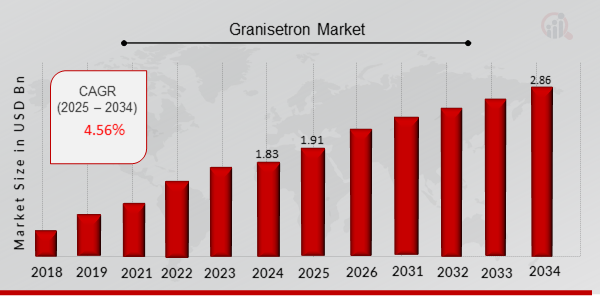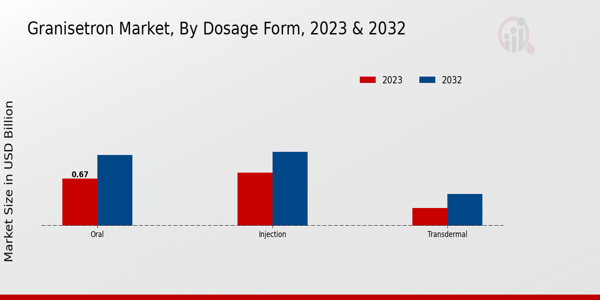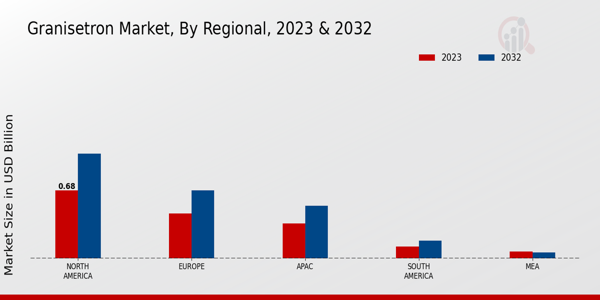Granisetron Market Overview
As per MRFR analysis, the Granisetron Market Size was estimated at 1.83 (USD Billion) in 2024. The Granisetron Market Industry is expected to grow from 1.91 (USD Billion) in 2025 to 2.86 (USD Billion) till 2034, at a CAGR (growth rate) is expected to be around 4.56% during the forecast period (2025 - 2034).
Key Granisetron Market Trends Highlighted
The Granisetron market is experiencing significant growth driven by the rising prevalence of nausea and vomiting associated with chemotherapy, radiotherapy, and surgery. Increased awareness among healthcare professionals and patients regarding the effectiveness of granisetron as a prophylactic treatment is fueling demand. Additionally, the rise in cancer cases has galvanized research and development activities, leading to the introduction of innovative formulations and delivery methods aimed at improving patient compliance and outcomes. As hospitals and clinics explore solutions to mitigate the side effects of cancer treatments, granisetron has emerged as a key player in supportive cancer care.Opportunities in the Granisetron market are being captured by advancements in drug formulations that aim to enhance the efficacy and safety profile of existing products. There is growing interest in the development of combination therapies that integrate granisetron with other antiemetic agents to provide comprehensive care for patients undergoing invasive procedures. The increasing adoption of electronic health records and telemedicine offers pathways to streamline patient management, improving accessibility to treatment options across various demographics. Furthermore, expansion into emerging markets presents a valuable opportunity for growth as the demand for effective anti-nausea solutions increases.Recent trends indicate a shift toward personalized medicine, where treatment plans are tailored to the individual needs of patients. The rise of online consultations and telehealth services has made it easier for patients to access specialized care and treatment plans involving granisetron. Healthcare professionals are increasingly focusing on patient-centered approaches, recognizing the significance of managing side effects effectively for enhancing the overall quality of life. This trend aligns with increased research efforts aimed at optimizing dosages and timing of granisetron administration to better suit patient needs. As such, the market is likely to continue evolving towards more nuanced care solutions that prioritize patient experiences and outcomes.
Fig 1: Granisetron Market Overview

Source: Primary Research, Secondary Research, MRFR Database and Analyst Review
Granisetron Market Drivers
Increasing Incidence of Nausea and Vomiting in Cancer Patients
The Granisetron Market Industry is witnessing significant growth driven by the increasing incidence of nausea and vomiting associated with cancer treatments, especially chemotherapy. Cancer therapies such as chemotherapy often lead to severe side effects, including nausea and vomiting, which can profoundly affect patients' quality of life. As more individuals are being diagnosed with cancer ly, there is a parallel need for effective management of these side effects.Granisetron, a highly effective serotonin 5-HT3 receptor antagonist, has emerged as a pivotal therapeutic option to combat chemotherapy-induced nausea and vomiting (CINV). With the growing awareness of patient-centered care and the importance of managing side effects effectively, healthcare practitioners are increasingly turning to Granisetron. Moreover, as advances in oncology continue to develop and more patients are treated with aggressive therapy regimens, the demand for potent antiemetic solutions is expected to rise, propelling the growth of the Granisetron Market Industry.Increased investment in cancer research, together with better screening practices and enrichment of cancer treatment pathways, is expected to further augment the market, establishing Granisetron as an essential cornerstone in supportive cancer care.
Robust Pipeline of Granisetron Formulations
The ongoing development of various Granisetron formulations, such as oral tablets and injectables, is significantly contributing to the growth of the Granisetron Market Industry. This diversification in formulations allows for better patient compliance, customization, and flexibility in treatment options, enabling healthcare professionals to tailor therapies to individual patient needs.
Growing Geriatric Population
The rise in the geriatric population is driving the demand for Granisetron as this demographic often faces cancer treatment and subsequently experiences higher rates of nausea and vomiting. As the elderly population continues to grow, the volume of patients requiring effective antiemetic therapy will also increase, thus bolstering the Granisetron Market Industry.
Granisetron Market Segment Insights
Granisetron Market Dosage Form Insights
The Granisetron Market, particularly within the Dosage Form segment, showcases significant growth potential, reflecting a notable increase in both consumer demand and product availability. As of 2023, this market is valued at approximately 1.67 USD Billion, with projections suggesting that it will reach around 2.5 USD Billion by 2032, demonstrating robust market growth trends over the coming years. Within the Dosage Form segment, Oral, Injection, and Transdermal forms contribute distinctly to the overall market dynamics. The Oral dosage form holds a market value of 0.67 USD Billion in 2023, set to rise to 1.0 USD Billion by 2032, indicating its strong appeal among consumers due to ease of administration and convenience.This segment exhibits majority holding due to patients' preference for non-invasive treatment options, which drives its demand. On the other hand, the Injection dosage form is valued at 0.75 USD Billion in 2023 and is forecasted to grow to 1.05 USD Billion by 2032. This segment is significant as it provides rapid pain relief and is often preferred in clinical settings where immediate action is required, emphasizing its importance in providing effective symptom management. Meanwhile, the Transdermal segment, valued at 0.25 USD Billion in 2023 and projected to rise to 0.45 USD Billion by 2032, showcases the least dominance in the market but still plays a critical role in offering sustained drug delivery and convenience for patients who may have difficulty with oral administration.Collectively, the Granisetron Market segmentation paints a picture of distinct preferences and evolving consumer needs, with the Oral and Injection forms dominating due to their practicality and effectiveness in real-world applications. The growing awareness of effective antiemetic treatments and their ease of use is shaping market strategies, offering numerous opportunities as innovations in formulation and delivery methods are further explored. Market growth within this segment will continue to be driven by advancements in pharmaceutical technologies and changing healthcare dynamics, alongside the ongoing emphasis on providing more patient-centric treatment options across the healthcare landscape.
Fig 2: Granisetron Market Insights

Source: Primary Research, Secondary Research, MRFR Database and Analyst Review
Granisetron Market Application Insights
The Granisetron Market, valued at 1.67 billion USD in 2023, showcases diverse applications that cater primarily to conditions associated with nausea. Among these, chemotherapy-induced nausea remains a critical area, driven by the increasing prevalence of cancer treatments. This segment commands significant attention, given the distress caused by nausea during chemotherapy. Postoperative nausea is another major application, reflecting the growing number of surgical procedures and the need for effective antiemetics to enhance patient comfort and recovery.Radiation-induced nausea is also noteworthy, as patients receiving radiotherapy often experience this debilitating side effect, presenting an opportunity for market growth. The overall market is characterized by a steady demand for granisetron across these applications, highlighting the importance of managing nausea effectively to improve patient outcomes. The Granisetron Market segmentation shows robust growth potential driven by advancements in treatment protocols and an increase in awareness regarding nausea management among healthcare providers, ultimately contributing to the overall market growth trajectory.
Granisetron Market End Use Insights
The Granisetron Market revenue demonstrates a robust expansion with a strong emphasis on the End Use segment, underscoring its significance in healthcare settings. In 2023, the market valuation reached 1.67 billion USD, reflecting the growing reliance on granisetron for managing nausea and vomiting associated with chemotherapy, radiotherapy, and surgery. Hospitals represent a central focus due to their substantial patient volume, where effective antiemetic therapies like granisetron play a crucial role in treatment regimens. Clinics also contribute significantly, catering to patients in outpatient settings with tailored therapy options.The growing trend towards Homecare services offers notable opportunities, as patients increasingly prefer receiving care in their own environments, which enhances the accessibility and utilization of granisetron. The Granisetron Market statistics indicate a steady demand across these environments, driven by factors such as rising cancer cases, increasing awareness of palliative care, and favorable reimbursement policies. However, challenges such as competition from alternative therapies and regulatory hurdles may impact market growth. Nevertheless, the ongoing advancements in drug formulations and the shift towards personalized medicine present valuable opportunities within the Granisetron Market industry.
Granisetron Market Distribution Channel Insights
The Granisetron Market, valued at 1.67 billion USD in 2023, showcases a well-structured Distribution Channel that significantly influences market growth. Within this channel, various pathways are pivotal for reaching end consumers, with Hospital Pharmacies, Retail Pharmacies, and Online Pharmacies being the primary conduits. Hospital Pharmacies play a crucial role due to their proximity to patients requiring immediate care, often leading to higher dispensing rates for Granisetron. Retail Pharmacies are essential for their accessibility and convenience, contributing substantially to the market as they cater to the ongoing demand from chronic patients needing frequent medication.Online Pharmacies have gained importance in recent years, driven by the surge in digitalization and consumer preference for home delivery, marking a significant shift in purchasing behaviors. Collectively, these distribution channels contribute to the Granisetron Market revenue, with market growth being fueled by trends such as an increase in cancer treatments and rising awareness about nausea management. Additionally, the market faces challenges, including regulatory hurdles and competition among channels, yet holds ample opportunities for expansion, especially in the online segment.The Granisetron Market segmentation reflects the diverse strategies employed to address these evolving consumer demands and enhance overall market dynamics.
Granisetron Market Regional Insights
The Granisetron Market revenue is showcasing substantial growth across various regions, with a projected valuation of 1.67 USD Billion in 2023. North America holds a significant position in this market, recording a value of 0.68 USD Billion in 2023, and is expected to further increase to 1.05 USD Billion by 2032, establishing it as the dominant region. Europe follows as the second-largest market, valued at 0.45 USD Billion in 2023 and anticipated to grow to 0.68 USD Billion. The Asia-Pacific (APAC) region accounts for a valuation of 0.35 USD Billion in 2023, with growth prospects bringing it to 0.53 USD Billion, showing strong potential fueled by increasing healthcare investments.Meanwhile, South America and the Middle East and Africa (MEA) represent smaller segments, with values of 0.12 USD Billion and 0.07 USD Billion in 2023, respectively. South America's market expected slight growth to 0.18 USD Billion while MEA is experiencing nearly stagnant growth with a slight decrease projected to 0.06 USD Billion. This regional segmentation highlights the dynamics of the Granisetron Market industry, where North America's majority holding demonstrates its robust healthcare framework, while APAC's emerging market signals a significant opportunity for growth driven by rising demand and evolving healthcare needs.
Fig 3: Granisetron Market Regional Insights

Source: Primary Research, Secondary Research, MRFR Database and Analyst Review
Granisetron Market Key Players and Competitive Insights
The Granisetron Market is poised for significant growth, driven by the increasing prevalence of chemotherapy-induced nausea and vomiting (CINV) among cancer patients, alongside a rising number of surgical procedures demanding effective antiemetic treatments. The competition in this market is characterized by a variety of pharmaceutical companies focusing on the development and distribution of granisetron-based products. These companies are striving to leverage advancements in technology and innovative formulations to enhance the efficacy and user experience, thereby increasing their market share. Strategic partnerships, mergers, and acquisitions are also prominent as companies seek to bolster their product offerings and expand their geographic reach. Understanding the competitive landscape involves evaluating not only the product portfolios of key players but also their marketing strategies, ability to navigate regulatory challenges, and overall market positioning.Roche has established a significant presence in the Granisetron Market through its continuous focus on research and development, which enables the company to innovate and refine its existing therapies. The company is known for its robust quality assurance protocols and its commitment to compliance with international regulatory standards, allowing for the introduction of high-efficacy products that cater to the needs of healthcare professionals and patients alike. Roche's strong distribution networks ensure that its granisetron products are accessible in multiple markets, further enhancing its competitive edge. The company's reputation for reliability and efficacy in the treatment of CINV sets a solid foundation for customer trust, which is pivotal in retaining market share in a competitive landscape. Additionally, Roche actively engages in educational initiatives for healthcare providers, ensuring that the latest clinical practices regarding its products are communicated effectively.Pfizer, on the other hand, is recognized for its extensive research endeavors and the breadth of its pharmaceutical portfolio, which includes granisetron, among other therapeutic agents. The company’s strategic focus on oncology is crucial as it aligns well with the needs of patients experiencing chemotherapy-induced side effects. Pfizer's strong investment in marketing and sales strategies aims to promote awareness about the importance of managing CINV, which is instrumental in driving demand for granisetron products. Furthermore, Pfizer leverages its footprint and established relationships with healthcare providers to ensure the high availability and accessibility of its granisetron offerings across various markets. The company’s commitment to advancing healthcare strategies through collaboration and partnerships underpins its capacity to innovate within the Granisetron Market, making it a formidable competitor. Its solid reputation for quality and efficacy in treatment fosters a loyal consumer base, enhancing Pfizer's standing within the realm of pharmaceutical competitors.
Key Companies in the Granisetron Market Include
Granisetron Market Industry Developments
Recent developments in the Granisetron Market have shown a notable increase in demand, driven by the need for effective antiemetic therapies in chemotherapy and postoperative care. Companies like Roche and Pfizer continue to expand their portfolios with innovative drug formulation strategies, particularly focusing on enhancing the efficacy and safety of Granisetron in various patient demographics. Competition is intensifying among key players such as Bristol-Myers Squibb, Fresenius Kabi, and Sandoz, who are striving to capture market share through strategic partnerships and product launches. The market is also witnessing a growing trend involving mergers and acquisitions, although no significant recent deals have been publicly reported among the specified companies such as Amgen, Merck, and Hikma Pharmaceuticals. Recent advancements in clinical trials for Granisetron derivatives from organizations like Genentech and Novartis are expected to enhance therapeutic options. Additionally, the surge in valuations across certain companies, including Sujan Pharmaceuticals, Mylan, and Teva Pharmaceutical Industries, reflects an optimistic outlook for the market as investment in research and development continues to foster innovation. These trends underline a dynamic landscape that suggests sustained growth and increased competitive pressure in the Granisetron Market.
Granisetron Market Segmentation Insights
Granisetron Market Dosage Form Outlook
- Oral
- Injection
- Transdermal
Granisetron Market Application Outlook
- Chemotherapy-Induced Nausea
- Postoperative Nausea
- Radiation-Induced Nausea
Granisetron Market End Use Outlook
- Hospitals
- Clinics
- Homecare
Granisetron Market Distribution Channel Outlook
- Hospital Pharmacies
- Retail Pharmacies
- Online Pharmacies
Granisetron Market Regional Outlook
- North America
- Europe
- South America
- Asia Pacific
- Middle East and Africa
| Report Attribute/Metric |
Details |
|
Market Size 2024
|
1.83 (USD Billion)
|
|
Market Size 2025
|
1.91 (USD Billion)
|
|
Market Size 2034
|
2.86 (USD Billion)
|
|
Compound Annual Growth Rate (CAGR)
|
4.56 % (2025 - 2034)
|
|
Report Coverage
|
Revenue Forecast, Competitive Landscape, Growth Factors, and Trends
|
|
Base Year
|
2024
|
|
Market Forecast Period
|
2025 - 2034
|
|
Historical Data
|
2020 - 2024
|
| Market Forecast Units |
USD Billion |
| Key Companies Profiled |
Roche, Pfizer, Bristol-Myers Squibb, Fresenius Kabi, Sandoz, Apexigen, Eisai, Amgen, Merck, Hikma Pharmaceuticals, Genentech, Novartis, Sujan Pharmaceuticals, Mylan, Teva Pharmaceutical Industries |
| Segments Covered |
Dosage Form, Application, End Use, Distribution Channel, Regional |
| Key Market Opportunities |
Increasing cancer prevalence, Expanding pharmaceutical applications, Growth in oncology care, Rising awareness of nausea management, Technological advancements in formulations |
| Key Market Dynamics |
Increasing cancer prevalence, Rising incidences of nausea, Technological advancements in formulations, Growing geriatric population, Expanding healthcare access and affordability |
| Countries Covered |
North America, Europe, APAC, South America, MEA |
Frequently Asked Questions (FAQ) :
The Granisetron Market is expected to be valued at 2.86 USD Billion in 2034.
The expected CAGR for the Granisetron Market from 2025 to 2034 is 4.56%.
North America holds the largest market share in the Granisetron Market, valued at 0.68 USD Billion in 2023.
The Granisetron Market in Europe is expected to grow to 0.68 USD Billion by 2032 from 0.45 USD Billion in 2023.
The Oral dosage form of the Granisetron Market is expected to reach 1.0 USD Billion by 2032.
Major players in the Granisetron Market include Roche, Pfizer, and Bristol-Myers Squibb.
The Injection dosage form is anticipated to reach 1.05 USD Billion in market size by 2032.
The Transdermal dosage form is valued at 0.25 USD Billion in the Granisetron Market in 2023.
The South America Granisetron Market is expected to be valued at 0.18 USD Billion by 2032.
The APAC region is projected to reach a market value of 0.53 USD Billion by 2032.

















